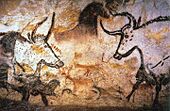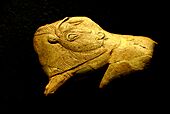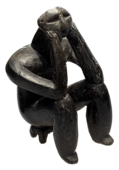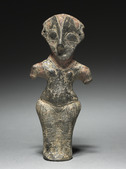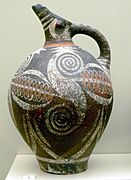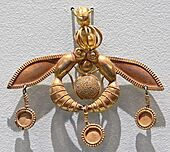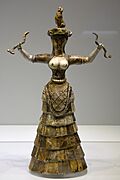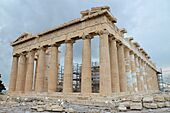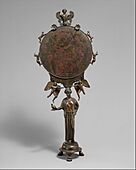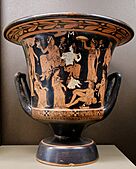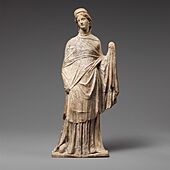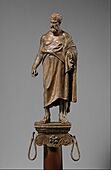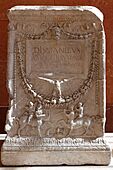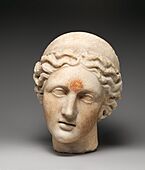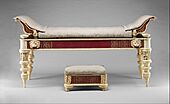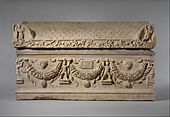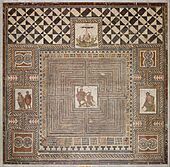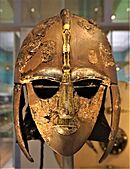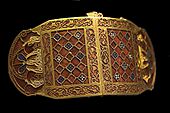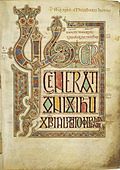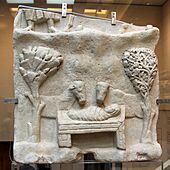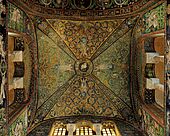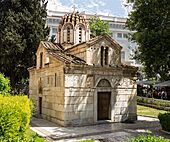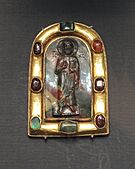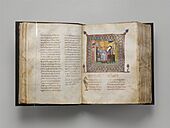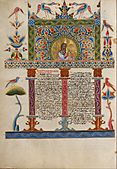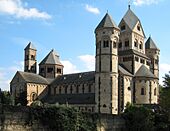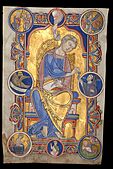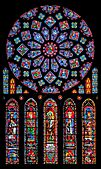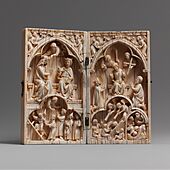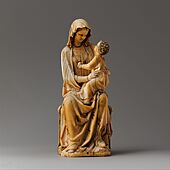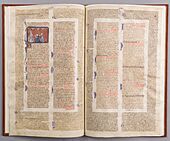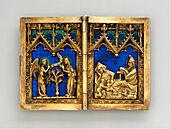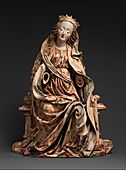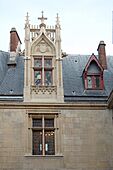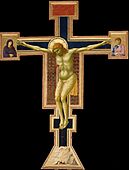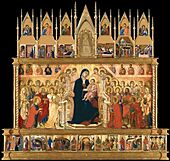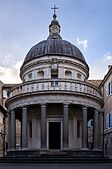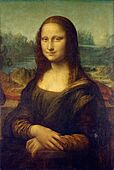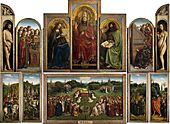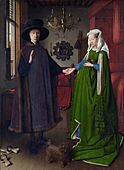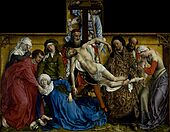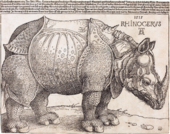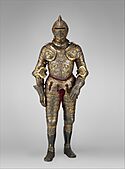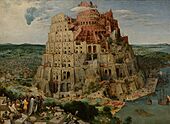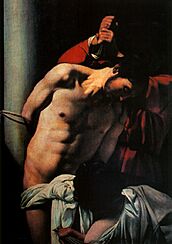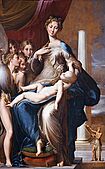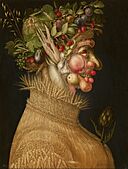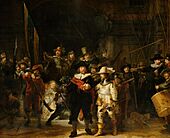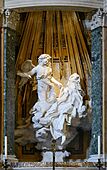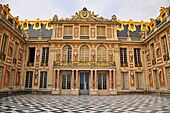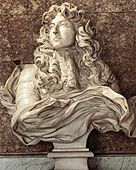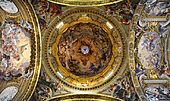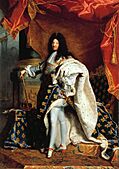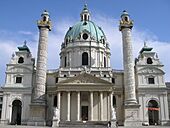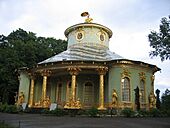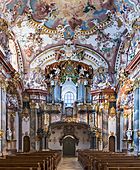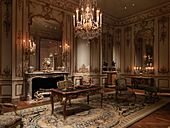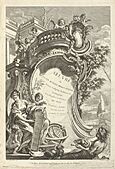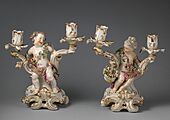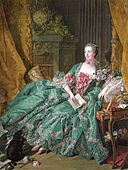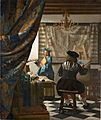Art of Europe facts for kids
The art of Europe, also known as Western art, covers the long history of visual art in Europe. It started with very old rock and cave paintings. These artworks were made between the Stone Age and the Iron Age.
Many art historians begin the story of European art with the ancient civilizations around the Aegean Sea, dating back to 3000 BC. But a clear pattern of art styles really began with Ancient Greek art. This style was later adopted and changed by Rome. The Roman Empire then spread this art across much of Europe, North Africa, and Western Asia.
The ideas of Classical art came and went over the next two thousand years. They seemed to disappear during parts of the Middle Ages. But then they came back strong in the Renaissance. Some early art experts thought art "decayed" during the Baroque period. Yet, classical ideas reappeared in a refined way in Neo-Classicism and were reborn in Post-Modernism.
Before the 1800s, the Christian church greatly influenced European art. The Church often paid artists for their work. During this time, people also became interested again in old myths, big wars, heroes, and non-religious topics. Most art from the last 200 years has not been about religion. It often doesn't have a special ideology either. But art has often been shaped by political ideas, showing what patrons or artists cared about.
European art is divided into many style periods. These periods often overlapped as different styles grew in different places. Generally, the periods are: Classical, Byzantine, Medieval, Gothic, Renaissance, Baroque, Rococo, Neoclassical, Modern, Postmodern and New European Painting.
Contents
- Discovering Ancient Art in Europe
- Art of the Middle Ages
- The Renaissance: A Rebirth of Art
- Mannerism, Baroque, and Rococo: Drama and Delight
- New Directions: Neoclassicism, Romanticism, and Realism
- Modern Art: Breaking New Ground
- Contemporary and Postmodern Art: Blurring Boundaries
- Images for kids
- See also
Discovering Ancient Art in Europe
Prehistoric Art: Europe's First Artists
European prehistoric art is a huge part of Europe's cultural past. The history of prehistoric art is usually split into four main times: the Stone Age, Neolithic, Bronze Age, and Iron Age. Most art pieces left from this time are small sculptures and cave paintings.
Many old artworks that still exist are small, portable sculptures. These include small female figures called Venus figurines, like the Venus of Willendorf (24,000–22,000 BC). These were found across central Europe. The 30 cm tall Löwenmensch figurine from about 30,000 BCE is very unique. The Swimming Reindeer from about 11,000 BCE is a beautiful carving of an animal made from bone or antler. These were made during the Upper Paleolithic period.
The oldest European cave art is 40,800 years old. You can find it in the El Castillo Cave in Spain. Other famous cave painting sites include Lascaux, Cave of Altamira, and Chauvet Cave. Rock painting was also done on cliff faces. But fewer of these have survived because of weather. One well-known example is the rock paintings of Astuvansalmi in Finland.
When the Magdalenian paintings of the Altamira cave in Spain were first found in 1879, experts thought they were fake. But new discoveries have shown they are real. This has made people more interested in the art of early humans. Cave paintings, made with simple tools, also give us clues about the culture and beliefs of that time.
The Rock art of the Iberian Mediterranean Basin shows a very different style. Human figures are the main focus, often in large groups. They show battles, dancing, and hunting. The figures are usually drawn simply with thin paint. The way groups of humans and animals relate to each other is shown more carefully than individual figures. These Iberian examples are thought to be from a long period, possibly covering the Upper Paleolithic, Mesolithic, and early Neolithic ages.
Prehistoric Celtic art comes from much of Iron Age Europe. It mostly survives as fancy metalwork. These pieces are skillfully decorated with complex, elegant, and mostly abstract designs. They often use curved and spiral shapes. There are human heads and some full animals. But full human figures are very rare. This might mean there was a religious rule against them. When the Romans took over Celtic lands, this art almost disappeared. But the style continued in the British Isles. It then came back strong with Christianity in the Insular style of the Early Middle Ages.
-
Cave paintings from Lascaux caves (Montignac, Dordogne, France)
-
Bison Licking Insect Bite; 15,000–13,000 BC; antler; National Museum of Prehistory (Les Eyzies-de-Tayac-Sireuil, France)
-
The Thinker of Cernavoda; by Hamangia culture from Romania; c. 5000 BC; terracotta; height: 11.5 cm (41⁄2 in.); National Museum of Romanian History (Bucharest)
-
Female figure; by Vinča culture from Serbia; 4500-3500 BC; fired clay with paint; overall: 16.1 cm; Cleveland Museum of Art (Ohio, US)
Minoan Art: Crete's Ancient Wonders
The Minoan civilization on Crete is thought to be the oldest civilization in Europe. Minoan art is known for its imaginative images and amazing craftsmanship. It is part of the larger group of Aegean art. Later, it greatly influenced Cycladic art. Wood and textiles have decayed, so most Minoan art that remains includes pottery, carved Minoan seals, palace frescos (including landscapes), small sculptures, jewelry, and metalwork.
Minoan art has many different subjects. Many of these appear across different materials. But only some pottery styles show figures. Bull-leaping appears in paintings and sculptures. It is thought to have had a religious meaning. Bull's heads are also popular in terracotta and other materials. There are no figures that look like portraits of real people or kings. The identities of religious figures are often unclear. Experts are not sure if they are gods, priests, or worshippers.
Animals, including many sea creatures, are often shown. The "Marine Style" is a type of painted palace pottery. It shows sea creatures like octopus spreading across the vessel. This style probably came from similar fresco scenes. Scenes of hunting and war, and horses and riders, are mostly found in later periods. These might have been made by Cretans for Mycenaean buyers.
Minoan figures, whether human or animal, feel very alive and moving. But they are often not very accurate. It's sometimes hard to tell what species an animal is. Compared to Ancient Egyptian art, they are often more vivid but less realistic. Compared to other ancient cultures, there are many female figures. Most human figures are shown from the side. Or they follow the Egyptian style with the head and legs from the side and the body from the front. But Minoan figures make features like slim male waists stand out.
-
Kamares ware beaked jug; 1850-1675 BC; ceramic; height: 27 cm; from Phaistos (Crete, Greece); Heraklion Archaeological Museum (Greece)
-
The fresco named the Bull-Leaping Fresco; 1675-1460 BC; lime plaster; height: 0.8 m, width: 1 m; from the palace at Knossos (Crete); Heraklion Archaeological Museum
Classical Greek and Hellenistic Art
Ancient Greece had amazing painters, sculptors, and architects. The Parthenon is a great example of their architecture that still stands today. Greek marble sculpture is often seen as the best form of Classical art. Paintings on pottery of Ancient Greece and ceramics give us a good look into how society worked in Ancient Greece. Black-figure vase painting and Red-figure vase painting show many examples of what Greek painting was like.
Some famous Greek painters on wooden panels are mentioned in old texts. These include Apelles and Zeuxis and Parrhasius. However, no examples of their panel paintings have survived. We only have written descriptions from people who lived at the same time or later Romans. Zeuxis lived around 5–6 BC. He was said to be the first to use sfumato, a technique that blends colors softly. According to Pliny the Elder, his paintings were so realistic that birds tried to eat the painted grapes. Apelles is described as the greatest painter of Ancient times. He was known for his perfect drawing, bright colors, and modeling.
-
The Parthenon on the Athenian Acropolis, a famous Greek temple built of marble and limestone between circa 460-406 BC, dedicated to the goddess Athena
-
The Grave relief of Thraseas and Euandria; 375-350 BC; Pentelic marble; height: 160 cm, width: 91 cm; Pergamon Museum (Berlin)
-
Volute krater; 320-310 BC; ceramic; height: 1.1 m; Walters Art Museum (Baltimore, US)
Roman Art: Influences and Innovations
Roman art was shaped by Greece. It can be seen as a continuation of ancient Greek painting and sculpture. But it was also greatly influenced by the local Etruscan art of Italy. Roman sculpture mostly focused on portraits of important people and gods. However, Roman painting has its own unique features.
Many surviving Roman paintings are wall paintings. A lot of these come from villas in Campania, Southern Italy, especially at Pompeii and Herculaneum. These paintings can be put into four main "styles" or periods. They might even contain the first examples of trompe-l'œil (trick of the eye), false perspective, and pure landscape art.
Almost all the painted portraits from the Ancient world that still exist are many coffin-portraits. These are bust-shaped and were found in the Late Antique cemetery of Al-Fayum. They give us an idea of how good the best ancient art must have been. A very small number of miniatures from old illustrated books also survive. More copies of them from the Early Medieval period exist. Early Christian art grew from Roman popular and later Imperial art. It took its iconography (symbols and images) from these sources.
-
Bronze statuette of a philosopher on a lamp stand; late 1st century BC; bronze; overall: 27.3 cm; weight: 2.9 kg; Metropolitan Museum of Art (New York City)
-
Augustus of Prima Porta; circa 20 BC; white marble; height: 2.06 m; Vatican Museums (Vatican City)
-
Restoration of a fresco from an Ancient villa bedroom; 50-40 BC; dimensions of the room: 265.4 x 334 x 583.9 cm; Metropolitan Museum of Art (New York City)
-
Altar with festoons; circa 50 AD; marble; height: 99.5 cm, width: 61.5 cm, depth: 47 cm; Louvre
-
Calyx-krater with reliefs of maidens and dancing maenads; 1st century AD; Pentelic marble; height: 80.7 cm; Metropolitan Museum of Art
-
Panoramic view of the Pantheon (Rome), built between 113 and 125
-
The Theseus Mosaic; 300-400 AD; marble and limestone pebbles; 4.1 x 4.2 m; Kunsthistorisches Museum (Vienna, Austria)
Art of the Middle Ages
Most art that survived from the Medieval period was religious. It was often paid for by the Church. Powerful church leaders like bishops, groups like abbeys, or rich non-religious people also funded art. Many artworks had specific uses in church services. For example, processional crosses and altarpieces.
A key question about Medieval art is why it wasn't very realistic. A lot of knowledge about perspective and the human body was lost when the Roman Empire fell. But realism wasn't the main goal for Medieval artists. They simply wanted to send a religious message. This task needed clear, symbolic images, not perfectly realistic ones.
Time Period: 6th century to 15th century
Early Medieval Art: Blending Styles
Migration period art is a term for the art of the "barbarian" peoples. These groups moved into areas that used to be Roman. Celtic art in the 7th and 8th centuries mixed with Germanic traditions. This happened through contact with the Anglo-Saxons. This created what is called the Hiberno-Saxon style or Insular art. This style greatly influenced the rest of the Middle Ages.
Merovingian art describes the art of the Franks before about 800 AD. Then, Carolingian art combined Insular influences with a deliberate return to classical styles. This developed into Ottonian art. Anglo-Saxon art is the art of England after the Insular period. Illuminated manuscripts contain almost all the surviving paintings from this time. But architecture, metalwork, and small carvings in wood or ivory were also important art forms.
-
Buckle of Sutton Hoo; 580–620; gold and niello; length: 13.1 cm; British Museum (London)
-
The helmet of Sutton Hoo; early 7th century AD; coppery alloy, iron, gold and garnet; height: 31.8 cm; British Museum
-
Shoulder-clasps from Sutton Hoo; early 7th century; gold, glass & garnet; length: 12.7 cm; British Museum
-
The Incipit to Matthew from the Book of Lindisfarne; late 7th century; ink and pigments on vellum; 34 x 25 cm; British Library (London)
Byzantine Art: Grand Mosaics and Icons
Byzantine art mixes with Early Christian art until the iconoclasm period (730-843 AD). During this time, most artworks with figures were destroyed. So little remains that any new discovery helps us understand more. After 843 until 1453, there is a clear Byzantine art tradition. It is often the best art of the Middle Ages in terms of material quality and craftsmanship. Most of it was made in Constantinople.
Byzantine art's greatest achievements were the huge frescos and mosaics inside domed churches. Most of these have not survived due to disasters or churches being turned into mosques.
-
Slab with a relief representing the Nativity of Jesus; 4th-early 5th century; marble; Byzantine and Christian Museum (Athens)
-
Apse of the Santa Maria Maggiore church in Rome, decorated in the 5th century with this glamorous mosaic
-
Mosaics on a ceiling and some walls of the Basilica of San Vitale in Ravenna (Italy), circa 547 AD
-
The Little Metropolis in Athens, built on unknown dates, between the 9th century to the 13th century
-
Cameo; 10th-11th centuries; jasper, almandine, emerald and chrysoprase; from Constantinople; Moscow Kremlin Museums (Russia)
-
Gospel lectionary; circa 1100; tempera, gold, and ink on parchment, and leather binding; overall: 36.8 x 29.6 x 12.4 cm, folio: 35 x 26.2 cm; Metropolitan Museum of Art (New York City)
-
Icon of the New Testament Trinity; circa 1450; tempera and gold on wood panel (poplar); Cleveland Museum of Art (Cleveland, Ohio, US)
-
Page of an Armenian illuminated manuscript; 1637–1638; tempera colors, gold paint, and gold leaf on parchment; height: 25.2 cm; Getty Center (Los Angeles)
Romanesque Art: Europe's First Unified Style
Romanesque art refers to the period from about 1000 AD until Gothic art appeared in the 12th century. This was a time of growing wealth. It was also the first time a clear art style was used across all of Europe, from Scandinavia to Sicily. Romanesque art is strong and direct. It was originally very colorful and often very complex. Stained glass and enamel on metalwork became important art forms. Larger, round sculptures also developed, though high relief (carvings that stick out a lot) was the main technique. Its architecture has thick walls, round-headed windows, and arches. It also features a lot of carved decoration.
-
Stone bas-relief of Jesus, from the Vézelay Abbey (Burgundy, France)
-
Miniature of Saint John the Evangelist; before 1147; illumination on parchment; 35.5 cm; Avesnes-sur-Helpe (France)
Gothic Art: From Cathedrals to Prints
Gothic art is a term that changes depending on the craft, place, and time. The term started with Gothic architecture in 1140. But Gothic painting didn't appear until around 1200. Gothic sculpture began in France in 1144 with the changes to the Abbey Church of S. Denis. It then spread across Europe. By the 13th century, it became the international style, replacing Romanesque.
International Gothic describes Gothic art from about 1360 to 1430. After this, Gothic art slowly blended into Renaissance art at different times in different places. During this period, forms like painting (frescos and panel paintings) became very important. New art forms like prints also appeared at the end of this time.
-
Part of the Royal Portal; 1145–1155; limestone; Chartres Cathedral (Chartres, France)
-
Scenes from the Legend of Saint Vincent of Saragossa; 1245–1247; pot-metal glass, vitreous paint, and lead; overall: 373.4 x 110.5 cm; Metropolitan Museum of Art (New York City)
-
Bifolium with the decretals of gratian; circa 1290; tempera and gold on parchment, brown ink, and modern leather binding; overall: 48.3 x 29.2 x 1.3 cm, opened: 47.2 cm; Metropolitan Museum of Art
-
Page of Très Riches Heures du Duc de Berry depictic the funeral of Raymond Diocrès; 1411-1416 and 1485–1486; tempera on vellum; height: 29 cm, width: 21 cm; Condé Museum (Chantilly, France)
-
The Lady and the Unicorn, the title given to a series of six tapestries woven in Flanders, this one being called À Mon Seul Désir; late 15th century; wool and silk; 377 x 473 cm; Musée de Cluny (Paris)
-
Austrian statue of Enthroned Virgin; 1490–1500; limestone with gesso, painted and gilded; 80.3 x 59.1 x 23.5 cm; Metropolitan Museum of Art
The Renaissance: A Rebirth of Art
The Renaissance is known for its focus on the art of Ancient Greece and Rome. This led to many changes in how paintings and sculptures were made, and what they were about. It started in Italy, a country rich in Roman history and money to pay artists.
During the Renaissance, painters made their work more realistic. They used new techniques in perspective to show three dimensions more truly. Artists also learned new ways to use light and darkness. For example, Titian used strong light and dark contrasts in his portraits. Leonardo da Vinci developed sfumato (soft blending) and chiaroscuro (strong light and shadow). Sculptors also rediscovered old techniques like contrapposto (a natural pose where the body's weight is shifted).
Following the humanist spirit of the time, art became less religious. It showed ancient mythology as well as Christian themes. This type of art is often called Renaissance Classicism. In Northern Europe, the most important Renaissance change was the wide use of oil paints. This allowed for richer colors and more detail.
From Gothic to the Renaissance: Italy's Artistic Shift
In the late 13th and early 14th centuries, much of the painting in Italy was Byzantine in style. This was true for Duccio of Siena and Cimabue of Florence. Meanwhile, Pietro Cavallini in Rome had a more Gothic style. During the 13th century, Italian sculptors began to get ideas not just from medieval art, but also from ancient works.
In 1290, Giotto started painting in a new way. It was less traditional and more based on observing nature. His famous paintings at the Scrovegni Chapel, Padua, are seen as the start of the Renaissance style.
Other painters of the 14th century made the Gothic style very detailed and elaborate. Simone Martini and Gentile da Fabriano are notable among these artists.
In the Netherlands, the technique of painting in oils instead of tempera allowed for great detail. This detail didn't rely on gold leaf or raised designs. Instead, it focused on showing the natural world very precisely. The art of painting textures with great realism grew at this time. Dutch painters like Jan van Eyck and Hugo van der Goes greatly influenced Late Gothic and Early Renaissance painting.
Early Renaissance: Florence Leads the Way
The first ideas of the Renaissance appeared in the city-state of Florence, Italy. The sculptor Donatello went back to classical techniques like contrapposto and classical subjects. His second sculpture of David was the first free-standing bronze nude made in Europe since the Roman Empire. The sculptor and architect Brunelleschi studied the building ideas of ancient Roman structures for inspiration. Masaccio improved elements like composition, individual expression, and human form. He painted frescos, especially those in the Brancacci Chapel, with surprising elegance, drama, and emotion.
Many of these important artists worked on different parts of the Florence Cathedral. Brunelleschi's dome for the cathedral was one of the first truly new architectural ideas since the Gothic flying buttress. Donatello created many of its sculptures. Giotto and Lorenzo Ghiberti also helped with the cathedral.
-
Pulpit in the Pisa Baptistery by Nicola Pisano; 1260; marble; height: 4.6 m.
High Renaissance: Masters of Perfection
High Renaissance artists include famous figures like Leonardo da Vinci, Michelangelo Buonarroti, and Raffaello Sanzio.
The artistic changes in Italy during the 15th century (like interest in perspective, anatomy, and classical cultures) became fully developed in the 16th century. That's why the 15th century is called "Early Renaissance" and the 16th century is "High Renaissance." While there isn't one single style for the High Renaissance, the art of its most famous artists—Leonardo da Vinci, Raphael, Michelangelo, and Titian—shows amazing skill, both technically and artistically. High Renaissance artists created artworks so powerful that future artists studied them for guidance.
These excellent artworks also made artists more respected. Artists could claim their ideas came from divine inspiration. This raised visual art to a level once only given to poetry. So, painters, sculptors, and architects became highly regarded. They successfully claimed a high place for their work among the fine arts. In a way, 16th-century masters created a new profession with its own rights of expression and its own respected character.
-
The Tempietto (towards 1502–1510) in a narrow courtyard of the San Pietro in Montorio from Rome
-
Mona Lisa; by Leonardo da Vinci; c. 1503–1506, perhaps continuing until c. 1517; oil on poplar panel; 77 cm × 53 cm; Louvre
-
The School of Athens; by Raphael; 1509–1510; fresco; 5.8 x 8.2 m; Apostolic Palace (Vatican City)
Northern Art up to the Renaissance
Early Netherlandish painting developed (but didn't invent) the technique of oil painting. This allowed for greater control in painting tiny details with realism. Jan van Eyck (1366–1441) was a key figure in the shift from illuminated manuscripts to panel paintings.
Hieronymus Bosch (1450?–1516), a Dutch painter, is another important artist in the Northern Renaissance. In his paintings, he used religious themes. But he mixed them with strange fantasies, colorful images, and peasant folk stories. His paintings often show the confusion and sadness linked to the end of the Middle Ages.
Albrecht Dürer brought Italian Renaissance style to Germany at the end of the 15th century. He was the leading artist of German Renaissance art.
Time Period:
- Italian Renaissance: Late 14th century to Early 16th century
- Northern Renaissance: 16th century
-
The Ghent Altarpiece; by Jan and Hubert van Eyck; 1432; oil on oak wood; 3.4 m × 4.6 m (opened like in this image); St Bavo's Cathedral (Ghent, Belgium)
-
The Arnolfini Portrait; by Jan van Eyck; 1434; oil on panel; 82.2 x 60 cm; National Gallery (London)
-
The Descent from the Cross; by Rogier van der Weyden; circa 1442; oil on oak panel; 220 × 262 cm; Museo del Prado (Madrid, Spain)
-
The Rhinoceros; by Albrecht Dürer; 1515; woodcut; 23.5 cm × 29.8 cm; National Gallery of Art (Washington, D.C.)
-
The Ambassadors; by Hans Holbein the Younger; 1533; oil on panel; 2.07 × 2.09; National Gallery (London)
-
The Parade Armour of Henry II of France; by Étienne Delaune; circa 1555; chased steel; height: 187.96 cm, weight: 24.2 kg; Metropolitan Museum of Art (New York City)
-
The Tower of Babel; by Pieter Bruegel the Elder; 1563; oil on panel: 1.14 × 1.55 cm; Kunsthistorisches Museum (Vienna, Austria)
Mannerism, Baroque, and Rococo: Drama and Delight
In European art, Renaissance Classicism led to two different movements: Mannerism and the Baroque. Mannerism was a reaction against the perfect ideals of Classicism. It used distorted light and space to show strong emotions in a painting and the artist's feelings. The work of El Greco is a very clear example of Mannerism in painting during the late 16th and early 17th centuries. Northern Mannerism took longer to develop. It was mostly a movement of the last half of the 16th century.
Baroque art took the realistic style of the Renaissance to new levels. It focused on detail, movement, lighting, and drama to find beauty. Some of the most famous Baroque painters are Caravaggio, Rembrandt, Peter Paul Rubens, and Diego Velázquez.
A different kind of art grew from northern realistic traditions in 17th-century Dutch Golden Age painting. This art had very little religious work or history painting. Instead, it played a key role in developing everyday art forms. These included still life, genre paintings of daily scenes, and landscape painting. While Rembrandt's art clearly shows Baroque traits, the term is less useful for Vermeer and many other Dutch artists. Flemish Baroque painting shared this trend. It also continued to produce traditional art categories.
Baroque art is often seen as part of the Counter-Reformation. This was the artistic side of a spiritual revival in the Roman Catholic Church. Also, the grandeur of Baroque art is seen as Absolutist. Religious and political themes were common in Baroque art. Both paintings and sculptures showed strong drama, emotion, and theatricality. Famous Baroque artists include Caravaggio and Rubens. Artemisia Gentileschi was another notable artist inspired by Caravaggio's style. Baroque art was very ornate and elaborate. It often used rich, warm colors with dark shadows. Pomp and grandeur were important parts of the Baroque art movement. For example, Louis XIV said, "I am grandeur incarnate." Many Baroque artists worked for kings who tried to achieve this goal. Baroque art was similar to Renaissance art in many ways. In fact, the term was first used negatively to describe post-Renaissance art and architecture that was too elaborate. Baroque art can be seen as a more detailed and dramatic version of late Renaissance art.
By the 18th century, Baroque art became less popular. Many people thought it was too dramatic and gloomy. It then developed into the Rococo style, which started in France. Rococo art was even more elaborate than Baroque. But it was less serious and more playful. While Baroque used rich, strong colors, Rococo used pale, creamy shades. This art movement no longer focused on politics and religion. Instead, it focused on lighter themes like romance, celebration, and enjoying nature. Rococo art also differed from Baroque because it often avoided symmetry. It preferred unbalanced designs. Also, it took ideas from the art and decorations of Far Eastern Asia. This led to the popularity of porcelain figurines and chinoiserie (Chinese-inspired art). The 18th-century style lasted for a short time. But Rococo soon fell out of favor. Many saw it as a showy and shallow movement that cared more about looks than meaning. Neoclassicism developed as a reaction against Rococo. It was driven by a dislike for Rococo's overly decorative style.
Mannerism (16th century)
-
Entombment; by Jacopo da Pontormo; 1525–1528; oil on panel; 3.12 x 1.9 m; Santa Felicita (Florence, Italy)
-
Madonna with the Long Neck; by Parmigianino; 1534–1540; oil on panel; 2.19 x 1.32 m; Uffizi Gallery (Florence)
-
Summer; by Giuseppe Arcimboldo; 1563; oil on panel; 67 x 50.8 cm; Kunsthistorisches Museum (Vienna, Austria)
Baroque (early 17th century to mid-early 18th century)
-
Dutch wardrobe; 1625–1650; oak with ebony and rosewood veneers; overall: 244.5 x 224.3 x 85.2 cm; Cleveland Museum of Art (Cleveland, Ohio, US)
-
The Night Watch; by Rembrandt; 1642; oil on canvas; 363 × 437 cm; Rijksmuseum (Amsterdam, the Netherlands)
-
The Ecstasy of Saint Teresa; by Gian Lorenzo Bernini; 1647–1652; marble; height: 3.5 m; Santa Maria della Vittoria (Rome)
-
Las Meninas; by Diego Velázquez; 1656–1657; oil on canvas; 318 cm × 276 cm; Museo del Prado (Madrid, Spain)
-
The entrance of the Palace of Versailles (Versailles, France), the most iconic Baroque building
-
The Art of Painting; by Johannes Vermeer; 1666–1668; oil on canvas; 1.3 x 1.1 m; Kunsthistorisches Museum
-
Dome of the Church of the Gesù (Rome), made in 1674 by Giovanni Battista Gaulli
-
The Portrait of Louis XIV; by Hyacinthe Rigaud; 1701; oil on canvas; 277 × 194 cm; Louvre
-
The Karlskirche in Vienna (Austria), built between 1716 and 1737
Rococo (early to mid-18th century)
-
The Chinese House, a chinoiserie garden pavilion in Sanssouci Park, from Potsdam (Germany)
-
Boiserie from the Hôtel de Varengeville; circa 1736–1752; various materials, including carved, painted, and gilded oak; height: 5.58 m, width: 7.07 m, length: 12.36 m; in the Metropolitan Museum of Art (New York City)
-
Pair of candelabrums; 18th century; soft-paste porcelain; heights (the left one): 26.8 cm, (the right one): 26.4 cm; by the Chelsea porcelain factory; Metropolitan Museum of Art
-
Mr and Mrs Andrews; by Thomas Gainsborough; circa 1750; oil on canvas; 69.8 x 119.4 cm; National Gallery (London)
-
Madame de Pompadour; by François Boucher; 1756; oil on canvas; 2.01 x 1.57 m; Alte Pinakothek (Munich, Germany)
-
The Swing; by Jean-Honoré Fragonard; 1767–1768; oil on canvas; height: 81 cm, width: 64 cm; Wallace Collection (London)
New Directions: Neoclassicism, Romanticism, and Realism
Throughout the 18th century, a movement against Rococo appeared in Europe. It was called Neoclassicism. It disliked the perceived shallowness and silliness of Rococo art. It wanted to return to the simple, ordered, and "pure" style of classical times, especially ancient Greece and Rome. This movement was also partly influenced by the Renaissance, which itself was strongly influenced by classical art.
Neoclassicism became widespread in Europe during the 18th century. Especially in the United Kingdom, where many great Neoclassical buildings appeared. Neoclassicism's interest in classical times can be seen in the popularity of the Grand Tour. During this time, rich nobles traveled to the ancient ruins of Italy and Greece.
A key moment for Neoclassicism came during the French Revolution in the late 18th century. In France, Rococo art was replaced by Neoclassical art. This new art was seen as more serious. In many ways, Neoclassicism can be seen as a political movement as well as an artistic and cultural one. Neoclassical art focuses on order, balance, and classical simplicity. Common themes in Neoclassical art include courage and war, often seen in ancient Greek and Roman art. Ingres, Canova, and Jacques-Louis David are among the most famous Neoclassicists.
Just as Mannerism rejected Classicism, Romanticism rejected the ideas of the Enlightenment and Neoclassical art. Romanticism disliked the very objective and ordered nature of Neoclassicism. It chose a more individual and emotional approach to art. Romanticism focused on nature, especially showing its power and beauty. It also emphasized emotions and a very personal way of making art. Romantic art was about individual feelings, not common themes like in Neoclassicism. Romantic art often used colors to express feelings and emotions.
Like Neoclassicism, Romantic art took much of its inspiration from ancient Greek and Roman art and mythology. However, unlike Neoclassical art, this inspiration was mainly used to create symbols and images. Romantic art also took many of its artistic qualities from medievalism and Gothic styles, as well as mythology and folklore. Among the greatest Romantic artists were Eugène Delacroix, Francisco Goya, J. M. W. Turner, John Constable, and Caspar David Friedrich.
Most artists tried to find a middle ground. They adopted different features of Neoclassicist and Romanticist styles to combine them. These attempts happened within the French Academy. They are collectively called Academic art. Adolphe William Bouguereau is a main example of this art style.
In the early 19th century, Europe changed greatly due to industrialization. Poverty and hardship became the fate of the new working class created by this "revolution." In response to these societal changes, the movement of Realism appeared. Realism aimed to show the true conditions and difficulties of the poor. It hoped to change society. Unlike Romanticism, which was generally hopeful about humanity, Realism showed a harsh view of poverty and despair. Similarly, while Romanticism praised nature, Realism showed life in the depths of urban areas. Like Romanticism, Realism was both a literary and an artistic movement.
Great Realist painters include Jean-Baptiste-Siméon Chardin, Gustave Courbet, Jean-François Millet, Camille Corot, Honoré Daumier, Édouard Manet, and Edgar Degas (both also seen as Impressionists).
Architecture responded to industrialization differently from other arts. It moved towards historicism, looking back at past styles. While railway stations built during this time are often seen as true reflections of the era's spirit (sometimes called "the cathedrals of the age"), the main architectural movements were revivals of old styles. Examples include the Gothic Revival. Related movements were the Pre-Raphaelite Brotherhood, who tried to return art to its "purity" before Raphael. The Arts and Crafts Movement reacted against mass-produced goods. It promoted a return to medieval craftsmanship.
Time Period:
- Neoclassicism: mid-early 18th century to early 19th century
- Romanticism: late 18th century to mid-19th century
- Realism: 19th century
Modern Art: Breaking New Ground
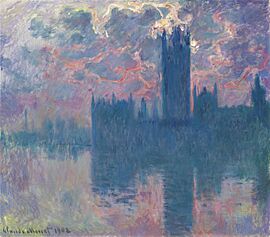

From the realistic ideas of Realism grew a major art movement: Impressionism. The Impressionists were pioneers in using light in painting. They tried to capture light as the human eye sees it. Edgar Degas, Édouard Manet, Claude Monet, Camille Pissarro, and Pierre-Auguste Renoir were all part of the Impressionist movement. Directly from Impressionism came the development of Post-Impressionism. Paul Cézanne, Vincent van Gogh, Paul Gauguin, and Georges Seurat are the most famous Post-Impressionists.
After the Impressionists and Post-Impressionists came Fauvism. This is often seen as the first "modern" art style. Just as the Impressionists changed how light was used, the Fauvists rethought color. They painted their canvases with bright, wild hues. After the Fauvists, modern art began to develop in many forms. These ranged from Expressionism, which aimed to show emotion through art, to Cubism, which tried to show a four-dimensional reality on a flat canvas, to Abstract art. These new art forms pushed the boundaries of what was traditionally considered "art." They matched the fast changes happening in human society, technology, and thinking.
Surrealism is often called a form of Modern Art. However, the Surrealists themselves have disagreed with studying surrealism as just an art history period. They say it makes the movement too simple. They also claim it misrepresents how surrealism relates to aesthetics (beauty). And it falsely says that ongoing surrealism is a finished, past era. Other forms of Modern art (some of which are close to Contemporary art) include:
- Abstract expressionism
- Art Deco
- Art Nouveau
- Bauhaus
- Color Field painting
- Conceptual Art
- Constructivism
- Cubism
- Dada
- Der Blaue Reiter
- De Stijl
- Die Brücke
- Body art
- Expressionism
- Fauvism
- Fluxus
- Futurism
- Happening
- Surrealism
- Lettrisme
- Lyrical Abstraction
- Land art
- Minimalism
- Naive art
- Op art
- Performance art
- Photorealism
- Pop art
- Suprematism
- Video art
- Vorticism
Time Period:
- Impressionism: late 19th Century
- Others: First half of the 20th century
Contemporary and Postmodern Art: Blurring Boundaries
Modern art showed some traits that would later define postmodern art. In fact, several modern art movements, like pop art, can be called both modern and postmodern. For example, postmodern art strongly uses irony, parody, and humor. Modern art started to develop a more ironic approach that would grow in a postmodern setting. Postmodern art blurs the lines between high (fine) arts and low-end or commercial art. Modern art began to experiment with this blurring.
Recent art changes have greatly expanded what can be considered art. This includes materials, media, activities, and ideas. Conceptual art in particular has had a wide impact. It started as replacing a physical object with an idea. One goal was to reject the idea of art being just a product to buy. However, it now usually refers to art where there is an object, but the main value comes from the thought process behind it. The idea of art as a product has returned.
There has also been more art that refers to older movements and artists. It gains value from these references.
Postmodernism in art, which has grown since the 1960s, is different from Modernism. Modern art movements mostly focused on their own activities and values. Postmodernism, however, uses all past movements as a starting point. This has created a flexible viewpoint, along with irony and some doubt about values. Each value can be seen as being replaced by another. Another result has been the growth of commercialism and celebrity.
Postmodern art has questioned common rules about what is considered 'fine art'. It mixes low art with fine arts until they are hard to tell apart. Before postmodernism, fine arts were known for beauty, elegance, skill, and intellectual stimulation. They were meant to appeal to the upper or educated classes. This separated high art from low art. Low art was seen as cheap, kitsch, easy to make, and lacking intellectual depth. It was meant to appeal to the general public. Postmodern art blurred these differences. It brought a strong element of kitsch, commercialism, and campness into modern fine art. What is now seen as fine art might have been considered low art before postmodernism changed the idea of what high or fine art truly is. Also, the postmodern nature of modern art allows for a lot of individuality in the art world. For example, postmodern art often takes ideas from past art movements, like Gothic or Baroque art. It then combines and reuses styles from these past periods in a new way.
Some surrealists, especially Joan Miró who called for the "murder of painting," have criticized or tried to "replace" painting. There have also been other anti-painting trends in art movements, like Dada and conceptual art. The trend away from painting in the late 20th century has been balanced by various movements. These include the continuation of Minimal Art, Lyrical Abstraction, Pop Art, Op Art, New Realism, Photorealism, Neo Geo, Neo-expressionism, New European Painting, Stuckism, Excessivism and other important painting styles.
Images for kids
-
The Art of Painting; by Johannes Vermeer; 1666–1668; oil on canvas; 1.3 x 1.1 m; Kunsthistorisches Museum (Vienna, Austria)
See also
- History of art
- History of painting
- Lives of the Most Excellent Painters, Sculptors, and Architects (16th century book)
- Modernism
- Painting in the Americas before European colonization
- Western European paintings in Ukrainian museums
- List of time periods


